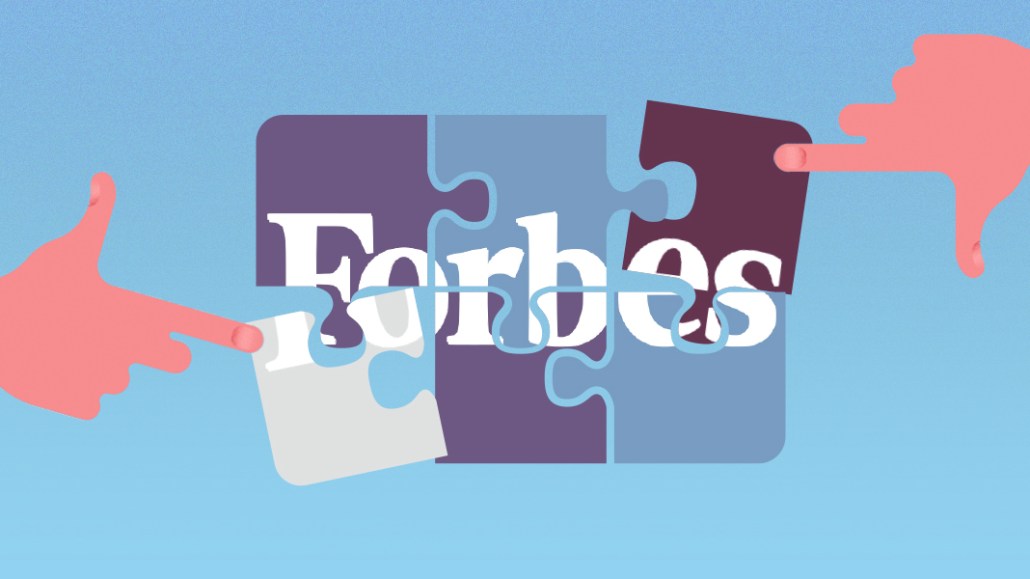Connect with execs from The New York Times, TIME, Dotdash Meredith and many more
Forbes Media’s content solutions now account for 40% of its direct revenue

Publishers that sought to diversify into new lines of business are now trying to figure out how to fit those operations back together to deepen their relationships with advertisers.
At Forbes Media, which merged its content studio with its research arm late last year, that realignment is driving more business in branded content. This year, it accounts for 40 percent of the revenue Forbes generated from its direct advertiser relationships last year; Forbes did not share what percentage of revenue the team drives from its relationship with ad agencies or other third parties.
Through the first half of 2019, Forbes has produced and distributed more branded content — over 400 pieces of text, video and social content — than it did through the entirety of 2018. Though Forbes had a hand in producing most of the content, it is also using its distribution channels to share content its clients create as part of its research as well.
BrandVoice, the content studio Forbes launched in 2010, has done this by merging with Forbes Insights, its research and analytics arm. Forbes Insights once operated as a separate line of business, helping clients with custom research. But combining the two operations together has led to record growth for BrandVoice, thanks both to brands’ growing content needs and to a unified sales staff that can begin pitching clients on multiple ways of working together sooner.
“We do think about extension quite a bit,” Forbes Media CRO Mark Howard said. “We have a single distribution channel, and either of those products, [Forbes- or brand-created] can flow through.”
Forbes originally created its Insights team to help brands with things like custom research. Over the past couple years, Howard said, Insights clients began asking more for research and help with projects related to content strategy and marketing, which were often good candidates for work created by BrandVoice, Howard said. Bringing the Insights team together with the BrandVoice team allowed both teams to upsell and work together more efficiently.
For example, A program it created for Teradata earlier this month will manifest in print and digital, through Forbes’s social channels and at live Forbes events. It will launch digital “issues” of content using a digital hub product that Forbes recently made available to advertisers. The contents of the campaign were created with assistance from BrandVoice, drawing on proprietary research conducted by Forbes Insights.
Other publishers, such as Atlantic Media and BuzzFeed, have focused on ensuring that different lines of business, including consulting, live events, research and advertising, can be threaded together more tightly to win the biggest possible business with advertisers.
Mergers typically create redundancies (and, later, layoffs), but in this case, joining two groups together simply gave both sales teams more people to pitch more business, and increased the manpower available to its operations team. Forbes plans to add a “double-digit” number of employees to its ranks this year, a Forbes spokesperson said.
For now, Howard said, the team has no plans to act like a full-fledged consultancy. Instead, it wanted to consult and advise them on communications, content and distribution strategies. “We’re not going to go in there and start to change [clients’] organizations,” Howard said. “We’re not going to rebrand as a media marketing consultancy. But the assets are there and the philosophy is there.”
Forbes had a healthy 2018. Profits were up 42 percent, highest in a decade for Forbes, CEO Mike Federle said, while declining to share specific figures. Digital advertising accounted for 49 percent, with events, reprints and insights accounting for 23 percent and licensing accounting for 10 percent.
More in Media

Three publishers’ workforce diversity reports show DEI efforts remain sluggish
Overall, staff diversity at The New York Times, Hearst and Condé Nast has either marginally improved or stalled in 2024, according to their annual workforce diversity data this year.

Retail media meets publishing: News UK, Future and Ocado tap clean room tech for smarter data targeting
News UK, The Independent, Immediate Media and Future are teaming up with retail media network Ocado to test clean room-powered data matching.

From sidelines to spotlight: Esports events are putting creators center stage
Esports events’ embrace of content creators reflects advertisers’ changing priorities across both gaming and the wider culture. In the past, marketers viewed esports as one of the best ways to reach gamers. In 2025, brands are instead prioritizing creators in their outreach to audiences across demographics and interest areas, including gaming.








